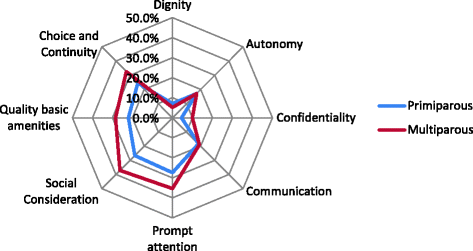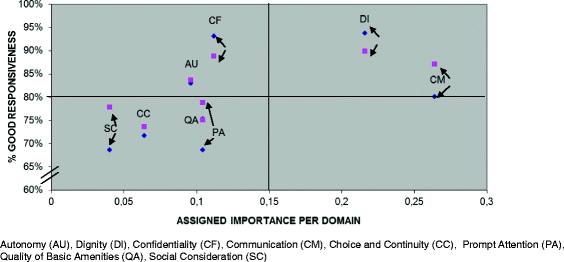Quality of perinatal care services from the user's perspective: a Dutch study applies the World Health Organization's responsiveness concept
- PMID: 28962611
- PMCID: PMC5622418
- DOI: 10.1186/s12884-017-1464-8
Quality of perinatal care services from the user's perspective: a Dutch study applies the World Health Organization's responsiveness concept
Abstract
Background: The concept of responsiveness was introduced by the World Health Organization (WHO) to address non-clinical aspects of service quality in an internationally comparable way. Responsiveness is defined as aspects of the way individuals are treated and the environment in which they are treated during health system interactions. The aim of this study is to assess responsiveness outcomes, their importance and factors influencing responsiveness outcomes during the antenatal and delivery phases of perinatal care.
Method: The Responsiveness in Perinatal and Obstetric Health Care Questionnaire was developed in 2009/10 based on the eight-domain WHO concept and the World Health Survey questionnaire. After ethical approval, a total of 171 women, who were 2 weeks postpartum, were recruited from three primary care midwifery practices in Rotterdam, the Netherlands, using face-to-face interviews. We dichotomized the original five ordinal response categories for responsiveness attainment as 'poor' and good responsiveness and analyzed the ranking of the domain performance and importance according to frequency scores. We used a series of independent variables related to health services and users' personal background characteristics in multiple logistic regression analyses to explain responsiveness.
Results: Poor responsiveness outcomes ranged from 5.9% to 31.7% for the antenatal phase and from 9.7% to 27.1% for the delivery phase. Overall for both phases, 'respect for persons' (Autonomy, Dignity, Communication and Confidentiality) domains performed better and were judged to be more important than 'client orientation' domains (Choice and Continuity, Prompt Attention, Quality of Basic Amenities, Social Consideration). On the whole, responsiveness was explained more by health-care and health related issues than personal characteristics.
Conclusion: To improve responsiveness outcomes caregivers should focus on domains in the category 'client orientation'.
Keywords: Birth care; Perinatal care; Quality of care; Responsiveness.
Conflict of interest statement
Ethics approval and consent to participate
All procedures performed in studies involving human participants were in accordance with the ethical standards of the institutional and/or national research committee and with the 1964 Helsinki declaration and its later amendments or comparable ethical standards. Study approval was granted by the Medical Ethical Committee, Erasmus Medical Centre, Rotterdam, the Netherlands, no MEC2012207.
Consent for publication
Not applicable.
Competing interests
Author Jacoba van der Kooy declares that she has no conflict of interest. Author Erwin Birnie declares that he has no conflict of interest. Author Nicole B. Valentine declares that she has no conflict of interest. Author Johanna P. de Graaf declares that she has no conflict of interest. Author Semiha Denktas declares that she has no conflict of interest. Author Eric A.P Steegers declares that he has no conflict of interest. Author Gouke.J. Bonsel declares that he has no conflict of interest.
Publisher’s Note
Springer Nature remains neutral with regard to jurisdictional claims in published maps and institutional affiliations.
Figures


Similar articles
-
How does mental health care perform in respect to service users' expectations? Evaluating inpatient and outpatient care in Germany with the WHO responsiveness concept.BMC Health Serv Res. 2007 Jul 2;7:99. doi: 10.1186/1472-6963-7-99. BMC Health Serv Res. 2007. PMID: 17605786 Free PMC article.
-
Validity of a questionnaire measuring the world health organization concept of health system responsiveness with respect to perinatal services in the Dutch obstetric care system.BMC Health Serv Res. 2014 Dec 3;14:622. doi: 10.1186/s12913-014-0622-1. BMC Health Serv Res. 2014. PMID: 25465053 Free PMC article.
-
Experiences of women who planned birth in a birth centre compared to alternative planned places of birth. Results of the Dutch Birth Centre Study.Midwifery. 2016 Sep;40:70-8. doi: 10.1016/j.midw.2016.06.004. Epub 2016 Jun 11. Midwifery. 2016. PMID: 27428101
-
Folic acid supplementation and malaria susceptibility and severity among people taking antifolate antimalarial drugs in endemic areas.Cochrane Database Syst Rev. 2022 Feb 1;2(2022):CD014217. doi: 10.1002/14651858.CD014217. Cochrane Database Syst Rev. 2022. PMID: 36321557 Free PMC article.
-
A framework for assessing the performance of health systems.Bull World Health Organ. 2000;78(6):717-31. Bull World Health Organ. 2000. PMID: 10916909 Free PMC article. Review.
Cited by
-
Potential of Standard Perinatal Data for Measuring Violation of Birth Integrity.Front Glob Womens Health. 2021 Feb 16;1:581244. doi: 10.3389/fgwh.2020.581244. eCollection 2020. Front Glob Womens Health. 2021. PMID: 34816160 Free PMC article.
-
A critical review: developing a birth integrity framework for epidemiological studies through meta-ethnography.BMC Womens Health. 2023 Oct 10;23(1):530. doi: 10.1186/s12905-023-02670-z. BMC Womens Health. 2023. PMID: 37817176 Free PMC article. Review.
-
Satisfaction with obstetric care in a population of low-educated native Dutch and non-western minority women. Focus group research.PLoS One. 2019 Jan 31;14(1):e0210506. doi: 10.1371/journal.pone.0210506. eCollection 2019. PLoS One. 2019. PMID: 30703116 Free PMC article.
-
Health system responsiveness in maternity care at Hadiya zone public hospitals in Southern Ethiopia: Users' perspectives.PLoS One. 2021 Oct 14;16(10):e0258092. doi: 10.1371/journal.pone.0258092. eCollection 2021. PLoS One. 2021. PMID: 34648538 Free PMC article.
-
Lived Experiences and Perceptions of Childbirth among Pastoralist Women in North-Eastern Ethiopia: A Multimethod Qualitative Analysis to the WHO Health Systems Responsiveness Framework.Int J Environ Res Public Health. 2021 Nov 28;18(23):12518. doi: 10.3390/ijerph182312518. Int J Environ Res Public Health. 2021. PMID: 34886246 Free PMC article.
References
-
- Ware JE, Snyder MK, Wright WR, Davies AR (eds.): Defining and measuring patient satisfaction with medical care. Evaluation and program planning; 1983. - PubMed
MeSH terms
Grants and funding
LinkOut - more resources
Full Text Sources
Other Literature Sources

